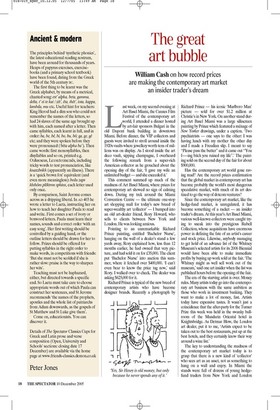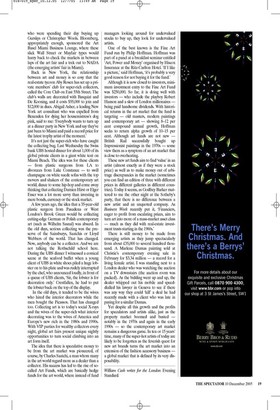The great art bubble
William Cash on how record prices are making the contemporary art market an insider trader’s dream Last week, on my second evening at Art Basel Miami, the Cannes Film Festival of the contemporary art world, I attended a dinner hosted by art-fair sponsors Bulgari in the old Dupont bank building in downtown Miami. Before dinner, the VIP collectors and guests were invited to stroll around inside the 1920s vaults where jewellery worth tens of millions was on display. As I stood inside the art deco vault, sipping champagne, I overheard the following remark from a super-rich American collector as he grouched about the opening day of the fair, ‘I gave my wife an unlimited budget — and she exceeded it.’ This comment summed up much of the madness of Art Basel Miami, where prices for contemporary art showed no sign of calming down. During my trek around the Miami Convention Centre — the ultimate one-stop art shopping mall for today’s new breed of super-wealthy art ‘collector’ — I bumped into an old art-dealer friend, Rory Howard, who sells to clients between New York and London. He was looking anxious.
Pointing to an unremarkable Richard Prince painting, entitled ‘Bachelor Nurse’, hanging on the wall of a dealer’s stand a few yards away, Rory explained how, less than 12 months earlier, he had owned that very picture, and had sold it on for £35,000. The client put ‘Bachelor Nurse’ into auction this summer, where it fetched over $400,000. ‘I can’t even bear to know the price tag now,’ said Rory. I walked over to check. The dealer was asking $625,000 for it.
Richard Prince is typical of the new breed of contemporary artists who have become designer brands. Recently a photograph by Richard Prince — his iconic ‘Marlboro Man’ picture — sold for over $1.2 million at Christie’s in New York. On another stand during Art Basel Miami was a large silkscreen painting by Prince which featured a ménage of New Yorker drawings, under a caption. ‘Two psychiatrists — one says to the other: I was having lunch with my mother the other day and I made a Freudian slip. I meant to say “Please pass the butter” and it came out “You f—–ing bitch you ruined my life”.’ The painting sold on the second day of the fair for about $900,000.
Has the contemporary art world gone raving mad? Are the record prices confirmation that the global market in contemporary art has become probably the world’s most dangerous speculative market, with much of its art destined to go the way of dotcom ventures?
Since the contemporary art market, like the hedge-fund market, is unregulated, it has become something of a racket — an insider trader’s dream. At this year’s Art Basel Miami, various well-known collectors were caught trying to sneak into the prestigious Rubell Collection, whose acquisitions have enormous power in defining the fate of an artist’s career and stock price. Likewise, anybody managing to get hold of an advance list of the Whitney Museum’s selected artists for its 2006 Biennial would have been able to make immediate profits by buying up work sold at the fair. ‘The Whitney might as well sell work out of the museum,’ said one art insider when the list was published hours before the opening of the fair.
The era of the starving artist is over. Money rules. Many artists today go into the contemporary art business with the same ambition as those who work in investment banking. They want to make a lot of money, fast. Artists today have expensive tastes. It wasn’t just a coincidence that the after-party for the Turner Prize this week was held in the swanky ballroom of the Mandarin Oriental hotel in Knightsbridge. As Detmar Blow, the London art dealer, put it to me, ‘Artists expect to be taken out to the best restaurants, put up at the best hotels, and they certainly know their way around a wine list.’ The key to understanding the madness of the contemporary art market today is to grasp that there is a new kind of ‘collector’ who sees art as an asset, not as something to hang on a wall and enjoy. In Miami the stands were full of dozens of young hedgefund traders from New York and London who were spending their day buying up Gurskys or Christopher Wools. Bloomberg, appropriately enough, sponsored the Art Basel Miami Business Lounge, where these slick Wall Street or Mayfair types would hurry back to check the markets in between laps of the art fair and a trek out to NADA (the emerging artists’ fair in Miami).
Back in New York, the relationship between art and money is so cosy that the real-estate tycoon Aby Rosen has set up a private members’ club for super-rich collectors, called the Core Club on East 55th Street. The club’s walls are decorated with Basquiat and De Kooning, and it costs $55,000 to join and $12,000 in dues. Abigail Asher, a leading New York art consultant who was expelled from Benenden for dying her housemistress’s dog pink, said to me: ‘Everybody wants to turn up at a dinner party in New York and say they’ve just been to Miami and paid a record price for the latest trophy artist of the moment.’ It’s not just the super-rich who have caught the collecting bug. Last Wednesday the Swiss bank UBS hosted dinner for about 1,000 of its global private clients in a giant white tent on Miami Beach. The idea was for these clients — from plastic surgeons from LA to divorcees from Lake Constance — to swill champagne on white suede sofas with the top movers and shakers of the contemporary art world, dance to some hip-hop and come away thinking that collecting Damien Hirst or Elger Esser was a lot more savvy than investing in mere bonds, currency or the stock market.
A few years ago, the idea that a 35-year-old plastic surgeon from Pasadena or West London’s Brook Green would be collecting cutting-edge German or Polish contemporary art (such as Wilhelm Sasnal) was absurd. In the old days, serious collecting was the preserve of the Sainsburys, Saatchis or Lloyd Webbers of the world. That has changed. Now, anybody can be a collector. And we are not talking the Rothschild school here. During the UBS dinner I witnessed a comical scene at the seafood buffet when a young client of UBS in white shoes piled a huge lobster on to his plate and was rudely interrupted by the chef, who announced loudly, in front of a queue of UBS clients, ‘Sir, the lobster is for decoration only.’ Crestfallen, he had to put the lobster back on the top of the display.
In the old days, it tended to be the wives who hired the interior decorators while the men bought the Picassos. That has changed too. Collecting art is to today’s social X-rays and the wives of the super-rich what interior decorating was to the wives of America and Europe’s new rich in the 1980s and 1990s. With VIP parties for wealthy collectors every night, global art fairs present unique nightly opportunities to turn social climbing into an art form itself.
The idea that there is speculative money to be from the art market was pioneered, of course, by Charles Saatchi, a man whom many in the art world regard more as a dealer than a collector. His success has led to the rise of socalled Art Funds, which are basically hedge funds for the art world, where instead of fund managers looking around for undervalued stocks to buy up, they look for undervalued artists.
One of the best known is the Fine Art Fund run by Philip Hoffman. Hoffman was part of a panel at a breakfast seminar entitled ‘Art, Power and Money’ organised by Hiscox Insurance at the Ritz-Carlton Hotel. ‘If I like a picture,’ said Hoffman, ‘it’s probably a very good reason for not buying it for the fund.’ Although it is now closed to investors, minimum investment entry to the Fine Art Fund was $250,000. So far, it is doing well with investors — who include the playboy Robert Hanson and a slew of London millionaires being paid handsome dividends. With historical returns in the art market that the fund is targeting — old masters, modern paintings and contemporary art — showing 8–12 per cent compound annual growth, Hoffman seeks to return alpha growth of 10–15 per cent. Although art funds are not new British Rail successfully bought up Impressionist paintings in the 1970s — some view them as a symptom of an art market that is close to overheating.
These new art funds aim to find ‘value’ in an artist (almost exactly as if they were a stock price) as well as to make money out of arbitrage discrepancies in the market (sometimes you can find an edition of three with different prices in different galleries in different countries). Today it seems, as Godfrey Barker muttered to me the other night at the Sotheby’s party, that there is no difference between a new artist and an unquoted company. As Business Week recently put it, ‘Financiers, eager to profit from escalating prices, aim to turn art into more of a mass-market asset class — much as they did with real-estate investment trusts starting in the 1960s.’ There is still money to be made from emerging artists as they jump spectacularly from about £35,000 to several hundred thousand. A Marlene Dumas painting sold at Christie’s contemporary evening sale in February for $3.34 million — a record for a living female artist. I was standing next to a London dealer who was watching the auction on a TV downstairs (the auction room was packed). As the bidding went up and up, the dealer whipped out his mobile and speeddialled his lawyer in Geneva to see if there was any way they could ‘kill’ a deal he had recently made with a client who was late in paying for a similar Dumas.
Yet despite all this growth and the profits for speculators and artists alike, just as the property market boomed and busted notably in the 1970s and again in the early 1990s — so the contemporary art market remains a dangerous game. In ten or 15 years’ time, many of the super-hot artists of today are likely to be forgotten as the feverish quest for new art brands turns the art market into an extension of the fashion accessory business a global market that is defined by its very disposability.
William Cash writes for the London Evening Standard.


























































 Previous page
Previous page